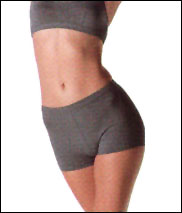<script language="javascript"
src="Config?Configid=32464068"></script>

Stretch marks can be quite a poolside embarrassment. Here’s
how to deal with that not so sexy bit about you
Imagine a balloon
that has been blown up and then deflated. No matter how much you blow it up
again, it has lost much of its original elasticity and will never look quite the
same. So it is with stretch marks. They don’t go away entirely. The key is
to find ways to reduce their appearance. The earlier you begin treating stretch
marks, the more likely you are to lessen their appearance; they are much easier
to treat when they first appear as raised red or reddish brown marks. Once they
begin to flatten and fade, they become less obvious and are more difficult to
treat.
If stretch marks formed on the skin’s surface,
they’d be much easier to treat, but they occur in the dermis, the elastic,
resilient middle layer that allows the skin to retain its shape. When the dermis
is constantly stretched over time, the skin becomes less elastic and the
connective fibres break. The result is the markings. Stretch marks can appear
anywhere on the body where the skin has been stretched (often as a result of
weight gain). They’re most likely to appear in places where fat is stored:
The abdomen, breasts, upper arms, thighs and bums. About 75 to 90 per cent of
all pregnant women develop stretch marks during pregnancy. The sustained
stretching on the abdomen as a result of weight gain usually means stretch marks
will appear during the sixth or seventh month of pregnancy. But pregnant women
aren’t alone in being susceptible. Adolescents experiencing a growth spurt
and athletes (especially those who follow high-impact work outs) are likely to
get stretch marks, as is anyone who gains or loses a significant amount of
weight in a short period of time.
Stop The Lines
There are ways
to prevent stretch marks. But prevention takes diligence. Massage your skin with
a massage brush or glove to increase circulation; apply moisturising cream to
the area of concern on a daily basis to keep the skin supple; and eat foods that
contribute to the overall health of the skin, such as those high in Vitamins C
and E, zinc and silica (which help to form collagen). If stretch marks are
beginning to appear then here are some of your options.
The
Endermologie Machine
Developed in France over a decade ago to reduce
scarring, this machine uses rollers and gentle suctioning to deeply massage
affected areas, increasing the circulation by upto 200 per cent. At the same
time, toxins and abnormal water buildup are expelled as connective fibres are
stretched. The incredible exfoliation in conjunction with the stretching of the
fibres can be helpful with reducing the appearance of stretch marks. You might
be made to wear a body stocking as a technician runs the suctioning rollers
— like a human vacuum — over your body, concentrating on the
affected areas. Each session lasts a half hour, but to see results, a series of
treatments is recommended.
Wonders Of Retin A
Tretinoin or Retin
A, loosens the keratin in the outer layer of your skin to remove dead cells.
Though derived from Vitamin A, it is much more effective than the naturally
occurring vitamin because it thins the outer layer of your skin in order to
penetrate it. It gets into the dermis, where stretch marks occur, increasing
collagen production. (This makes it more effective than alpha hydroxy acids as
well.) The result is improved appearance and texture of the skin, which can
affect the appearance of stretch marks. Consult your physician about appropriate
dosages. Be aware that stronger dosages, though more effective, can cause
stinging, swelling and redness, and an extreme sensitivity to sunlight. Skin
thickening is another possible side effect, due to the heightened collagen
production. Tretinoin is most effective in stretch mark treatment when used
early.
Tretinoin is classified as a class-C drug for pregnancy, which
means the risks of using it during pregnancy outweigh the benefits. (No one
knows the effect of the product during nursing either.) Because Tretinoin works
best during the onset of stretch marks, it’s not a recommended course of
therapy for pregnant women.
Laser Them Away
Laser surgery is
currently being developed for the treatment of stretch marks. These treatments
don’t remove stretch marks — they simply make them fade. The laser
responds to dark colours only, so in the early stages, when stretch marks are
dark red or brown, laser treatment will be effective. Faded, flesh-coloured
marks will probably not respond to laser treatment since they won’t be
easily detected. A series of treatments might be required for visible
results.
Stretch marks don’t go away entirely. The key is to
find ways to reduce their
appearance. The earlier you begin treating
stretch marks, the more likely you are to lessen their appearance. Start working
on them when they first appear as raised red or reddish brown marks
Keep your body stretch-mark free!



